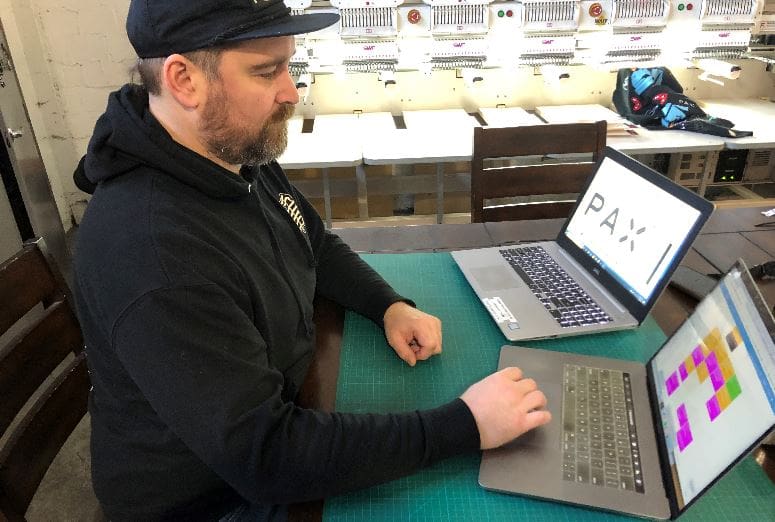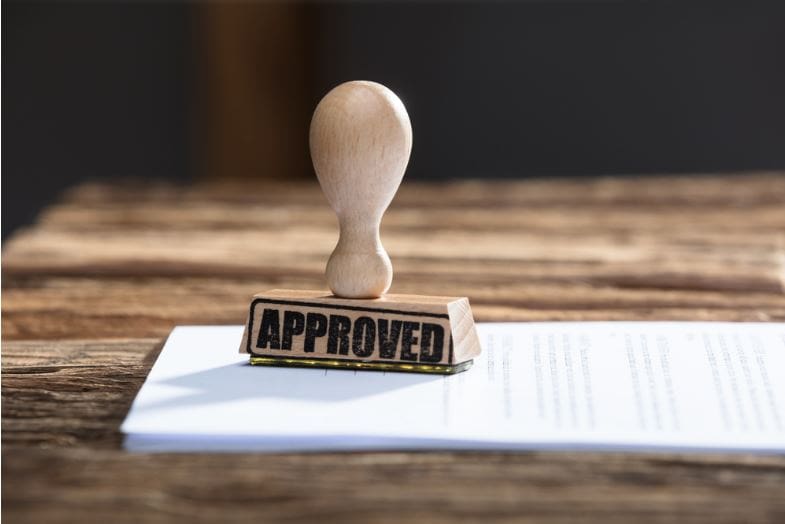If you’ve been considering starting an enterprise with limitless earning potential, start an embroidery business!
That’s what Forrest Wedmore and his partner Clint Graham did by opening the Foundry Printshop. Forest got into the industry by buying a struggling T-shirt company for $10,000—money he borrowed from a family member.
Since those humble beginnings, he’s moved his enterprise into a roomy 4,000 square foot facility fully stocked with state-of-the-art embroidery equipment.
This year, he’s making a whopping $3,500 a day, which puts him on track to double his growth. In fact, when all is said and done, he’ll have generated revenues in the high 6 figures!
Dive into this article, and you’ll find out every single thing you need to know to start an embroidery business.
You’ll learn things like how to differentiate yourself from your competitors, which embroidery equipment you’ll need, how to start a home-based embroidery business, and so much more.
We interviewed Forrest to find out how he started the Foundry Printshop. He’s got lots of actionable secrets he’s dying to share with you!
Watch both part 1 and part 2 of that interview if you’re contemplating starting a cleaning business.
What Does an Embroidery Business Do?
Embroidered apparel is a business with huge earning potential.
It’s incredibly easy to get started with only a decent embroidery machine, a few other pieces of equipment, and some basic embroidery skills.
Thousands of companies all over the world are looking to beef up their brand awareness. They can do just that with logos that you emblazon on caps, sweatshirts, face masks, and other apparel.
You can also market your embroidery designs to sports teams, schools, clubs, and other organizations and companies.
You could choose to embroider T-shirts, although Forest says this is a business with lots of competition.
Forest says that jackets, hoodies, and fleeces are more profitable. You can even start related businesses like screen printing and T-shirt printing to maximize your earning potential—just like he did!
Alternatively, consider opening a boutique to work with clothing without being involved in manufacturing.
15 Steps to Your Own Custom Embroidery Business
Here are the precise steps you’ll need to follow to start your own machine embroidery business:
Step 1: Differentiate Yourself from Your Competitors
Forest has found unique ways to make his machine embroidery business stand head and shoulders above all the other embroidery businesses that are his competition. Here’s one way he does that:
By only allowing his clients to buy high-quality garments from him, he accomplishes two things:
- Keeps his profit margins sky-high
- Makes his embroidery customers deliriously happy
Here’s what else Forest had to say on this topic:
The Best Way To Differentiate Yourself
Say you want to leave your competition in the proverbial dust. In that case, you need to know their businesses, strategies, and services inside and out.
Keep a hyper-focused eye on everything they do so you’ll know what their next move is—even before they do!
By knowing exactly who it is you’re competing against, you’ll be able to ensure your offerings are orders of magnitude better than theirs.
Step 2: Learn Everything You Can About the Embroidery Industry

If you currently know nothing about commercial embroidery, you’re going to need to acquire some knowledge about the embroidery industry.
Try to find an experienced embroiderer so he can take you under his wing and teach you what you need to know. You should also read everything you can in books about custom embroidery.
YouTube has some fantastic tutorials on commercial embroidery.
Join embroidery and custom apparel organizations to get the latest news, trends, and tips for starting your embroidery company.
One of the very best organizations to join is the Embroidery Trade Organization (ETA). This association will allow you to take advantage of the market with new training, marketing secrets, and networking opportunities.
You can also attend trade shows to schmooze with suppliers and owners of other embroidery businesses so you can pick their brains.
Step 3: Buy Your Commercial Embroidery Equipment
You’re going to need equipment to start your embroidery business.
The most critical piece of equipment you’ll need to purchase is an embroidery machine. Choosing the wrong embroidery device can hurt your business, so choose wisely.
Another option is buying an existing embroidery business. This saves you the effort of finding a space and purchasing equipment. You can find businesses for sale near you online.
With computerized embroidery machines, the artwork for your design is fed into the computer. You see the embroidery design on the computer monitor and can change the design according to your needs.
If you want to buy an embroidery machine, check out Sewing Machines Plus. They offer such well-known brands as Janome and Juki.
Look for embroidery machines that offer training and support because mastering the software can be difficult.
You can begin on a shoestring budget by buying a home embroidery machine or embroidering by hand. When your business takes off, you can invest in a bigger machine.
Choosing an embroidery machine depends on the niche you’re aiming for. If you’re doing T-shirts, you’ll need a machine that can do tubular sewing.
If you’re thinking of doing embroidered patches, you’ll need an entirely different type of machine.
What is the Best Embroidery Machine to Start a Business?
For a home-based business, the best embroidery machine is the Janome Horizon Memory Craft 12000.
This is an exceedingly versatile device that not only embroiders but also sews and quilts. It’s super easy to use and is quite efficient, so embroidery projects get completed quickly.
Other Embroidery Equipment and Supplies

Here are some other things you’ll need to start your own embroidery company:
- Caps
- T-Shirts
- Polo Shirts
- Shirts
- Jackets
- Sweatshirts
- Computer
- Printer
- Digital Design Software
- Hooping Boards
- Specialty Sewing Kits
- Embroidery Thread
- Topping Material
- Backing
- Bobbins
- Needles
- Stock Designs
You can get discount supplies for your embroidery business here.
Step 4: Don’t Take on Too Many Projects
When you start your embroidery business, it’s tempting to take on multiple projects. However, this is a recipe for failure. In the beginning, focus on two or three things so you don’t diffuse your efforts.
Here’s how Forest puts it:
Step 5: Don’t Try to Do Everything Yourself
In the beginning, Forest tried to do everything himself.

Today, he has come to the realization that he should stick to what he’s good at. That’s the embroidery, screen printing, and graphic designing which has been his bread and butter.
One of the things he contracts out is accounting:
As far as bookkeeping services go, I recommend Bench or Bookkeeper.com.
Step 6: Create An Embroidery Business Plan
A business plan is crucial to the success of your embroidery business.
Without one, you’re like a ship adrift at sea. With one, you’ll be able to confidently chart a course from where you are now to right where you want to be with your embroidery company.
You’re going to need the following six sections:
- EXECUTIVE SUMMARY: This is a quick overview of your business. It’s one or two pages at the most. Wait and write it last, as it’s a summary of the rest of your plan.
- OPPORTUNITY: This is the place where you tell the world what you’re selling, what problem you’re solving, who’s your target audience, and who your competition is. In other words, the opportunity your business represents to yourself and investors.
- EXECUTION: Now comes the exciting part—how are you going to seize the opportunity you just described and transform it into a viable business? You’ll also need to include your marketing and sales plan and the metrics and milestones that will track your success.
- MANAGEMENT SUMMARY: Use this section to list your current team configuration and who you might need to add to make it complete. If you’re already up and running, provide a quick overview of your legal structure, location, and history.
- FINANCIAL PLAN: Your business plan isn’t finished unless you have an economic forecast. Here is where you’ll put a cash flow statement, income statement (or profit and loss statement), and your balance sheet.
- APPENDIX: If you need space for additional information, you can tuck it in here.
If you need free business plan templates, I would check out the one-page business plan at Fit Small Business. If you need state-specific ones, check out Rocket Lawyer.
If you need help crafting a business plan, check out this resource at the SBA. SCORE also has some resources you might want to look at it.
Step 7: Get Your Licenses and Permits

Before you can set up your embroidery shop, you’ll need to make a quick call to the various government offices to find out which licenses or permits you’ll need. Some of these offices are federal, some are state, and some are local.
If you’re starting an embroidery business, here are the permits or licenses you might need:
- FICTITIOUS NAME/DBA: A fictitious name (otherwise known as a DBA, or “Doing Business As”) is a permit to do business in a locality. This permit is required if your business name is different from your owner’s name.
- LOCAL BUSINESS LICENSE: Some cities or counties require a business license for new businesses, even if the company is already registered with the state.
- BUILDING PERMIT: If your business is in a new location or you’re renovating an existing one, you’ll need a building permit.
- FIRE INSPECTION CERTIFICATE: A fire safety inspection certificate is issued after an inspection from the fire department to ensure that your building meets stringent fire safety regulations.
- SELLER’S PERMIT: This is a permit issued by the state letting you sell products or services and collect sales tax.
- REGISTER AS AN EMPLOYER: States require employers to register with them as employers for state tax purposes. Specifically, you must comply with state tax regulations for unemployment tax and workers’ compensation.
You can find out which licenses you’ll need for your embroidery company in your state. For more assistance applying for licenses and permits, check out the SBA website.
Step 8: Get Insurance
You’re going to need small business insurance to protect yourself from risk and financial loss in the event of an unexpected catastrophe with your embroidery company.
Small business insurance (or commercial insurance) will help protect your embroidery company’s assets, property, and income. The most common type of policy for small businesses is a business owners’ policy (BOP).
It includes 3 basic types of coverage:
- Business property coverage
- General liability coverage
- Business interruption coverage
My recommendations?
Go with Progressive Commercial, Liberty Mutual, or Embroker.
Additional resources for insurance for small businesses include this article at FreshBooks and this other article at the Small Business Administration.
Step 9: Set Up Your Website
You’ll need a website for your embroidery business to keep existing customers in the loop and explain your value proposition to new customers. A website also helps to drive embroidery sales and boost brand recognition.
First, you need to choose a domain name and secure web hosting. For this, I recommend WordPress. You’ll also need to register your domain name at GoDaddy.

Next, you’ll need to optimize your website. This will improve your search engine rankings and drive traffic. Ensure your website is optimized for mobile devices since most of your customers will use one to check out your website.
You can use email marketing to send business updates to visitors.
To hone your email marketing skills, read this article at WP Beginner. The US Chamber of Commerce has another terrific article you might want to read before you get your email campaigns off the ground.
Use Word of Mouth Advertising
One of the quickest ways to drum up customers for your fledgling embroidery business is through word-of-mouth advertising.
So, let friends, relatives, and business associates know you’re starting an embroidery company.
Here’s a terrific article to read if you want to learn more about word-of-mouth marketing.
Getting Your Embroidery Business Ranked on Google
Many small businesses salivate at the prospect of getting ranked on the first page of Google.
There’s a compelling reason for this: 92% of Internet users only look at Google’s front page when they’re searching for something.
What’s more, the people who discover your website through a Google search tend to stay on your website longer than visitors sent there via social media.
What more proof do you need that ranking high in the SERPs is good for your business?
If you want to boost your SEO, check out digital marketing agencies or find an expert on Upwork. You should also get a Google Ads account.
Step 10: Harness the Power of Social Media

In just a few short years, social media has emerged as an incredibly effective marketing method for businesses of all sizes.
That’s why you’d have to be a lunatic to ignore the exponential power of social media when you’re considering ways to promote your business.
Here’s one superb way Forest takes advantage of this powerful tool:
If you want to take a deep dive into the subject, read this article.
Step 11: Set Your Embroidery Prices
Embroidery prices are usually based on a per-thousand stitch rate—which is multiplied by the number of pieces. So, you could charge a fixed fee for every thousand stitches, or an hourly rate.
Here’s an article put out by the SBA for further information about setting prices.
Step 12: Invest Your Money Wisely
Money’s going to be scarce in the beginning. That’s why you need to make some difficult decisions on where you’re going to spend your cash to grow your business.
Here’s Forest again:
If you want to read more about budgeting for small businesses, check out this article.
Step 13: Always Pay Your Bills on Time

Forest prides himself on making sure his embroidery business remains financially responsible. Here’s what he has to say on the topic:
Step 14: Leverage Your Existing Relationships
Forest attributes much of his success to his ability to leverage existing relationships he built up in the previous industry he worked:
In any business, relationships are everything. If you don’t have any, start acquiring some.
If you don’t have that customer base, he recommends this:
For more on building a customer base, read this article.
Step 15: Have Fewer Employees (But Pay Them Better)
Forest believes one pillar of his success is having fewer employees. This way, he can pay the ones he has better. This increases their motivation to do impeccable work:
He also works hard so that he sets a good example:
For more on what you should pay your employees, read this article.
How to Start an Embroidery Business from Home

If you’re strapped for cash, you can always start your embroidery business from home. You’ll need a clean space that’s big enough to hold your embroidery machine, computer, and embroidery supplies.
You probably should purchase a computer that’s entirely dedicated to your at-home embroidery business.
In other words, don’t use your personal computer. That’s because this way, essential business files won’t get deleted, and you’ll be better organized so your embroidery operation can run at peak efficiency.
You’ll also need some office space to store files and for doing administrative tasks.
How Much Money Can You Make with an Embroidery Business?
Forest’s breakeven point is $1,200 a day:
After that point, everything you make is pure, unadulterated profit!
On an average day, he makes about $3,500 in embroidery business income.
On a good day, he makes $5,000 or more!
Final Thoughts
I just told you everything you need to know when starting an embroidery business.
By doing so, you’ll be following in the footsteps of Forest Wedmore, who’s enjoying the fruits of his hard work by generating revenue measured in the high 6 figures each year.
Wouldn’t you love to experience this level of success?
It’s possible if you follow the steps in this article!
Which strategy did you find most useful?
Let me know in the comments!




